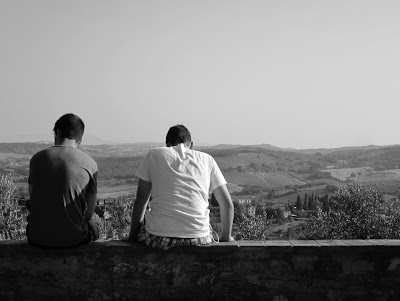 Please note: this review contains spoilers
Please note: this review contains spoilers
From the very first image of Pawel
Pawlikowski's Ida, something
important is immediately apparent: it's absolutely stunning to look at. And
what's more, the images are square, once more proving the power – dare I say
the superiority? – of full frame ratios. As the near-wordless opening minutes
unfold, the film's crisp black and white images and measured pace lull the
viewer into an increasing awareness that the film has been assembled by someone
with a complete mastery of the cinematic medium. People are pushed to the
corners of the frame, like Joan of Arc in Dreyer's masterpiece, and the austere
mood recalls Bresson's famous maxim that you should 'build your film on white,
on silence, and on stillness'. It's almost as if Pawlikowski is throwing down
the gauntlet and stepping forward to claim the hole left by the retirement of Béla
Tarr. I must confess to being ignorant about Pawlikowski's prior work, and I
can't claim to know his future intentions, but Ida certainly belongs to the tradition of these great masters, and
lives up to every bit of promise that the association brings.
A young nun, Sister Anna (a
tremendous Agata Trzebuchowska), is ordered by the Mother Superior of the
convent where she was raised to meet her only living relative, Wanda Gruz (an
equally excellent Agata Kulesza), before confirming her vows. Reluctantly, Anna
visits Wanda at her apartment, where she is confronted by some shattering home
truths: not only is Anna really called Ida, but she is also Jewish – not
Christian. Furthermore, Ida's parents are dead and, like so many other Jews
murdered in the Second World War, have no graves. From here, Ida and Wanda
venture out on a journey to discover how Ida's parents died, and where they are
buried.
Together, Ida and Wanda are an
unlikely couple, almost Kazantzakian in their differences: where Ida is meek
and mild, Wanda charges like a bulldog, a literally threatening presence (she tells
one person they ask for information that she can 'destroy' them, and admits to
Ida that in her heyday she was a state prosecutor and sentenced many people to
their deaths). But when Wanda takes hold of Ida's Bible during an argument, a
latent force flashes forth from Ida – these women are not one dimensional caricatures,
and this is one sign of many that perhaps they are not as different as they
first appear.
For the briefest moment, the
road trip aspect of the film, in which the women from different generations
drive to Wanda's hometown, seems to recall memories of Wild Strawberries. But such a comparison would be misleading, for
there is no overt psychologising or philosophising here (there is also no
sentimentality, just an almost Antonionesque distancing
– but I think I've already name checked enough masters, so let's not dwell
further on that). The meaning in Ida seeps
out from within, with Anna/Ida experiencing something akin to a crisis of
identity after discovering her birth name and religion (she is, as Wanda tells
her, a 'Jewish Nun'). When Ida and Wanda eventually find the remains of Ida's
parents, they exhume them and move them elsewhere, to rebury them in a family grave.
But can the past really be so easily (re)buried? At one point Ida sits talking
to a young saxophone player the women have befriended, while behind them a
window's ironwork seems to entrap them like a spider's web. Perhaps there is no
getting away from who we are and the legacy our parents leave us – and perhaps,
for Poland and the rest of the world, there is no escaping the legacy of the Second
World War. Just as Wanda's past work has placed blood on her hands, so too is
there blood on our national heritage, and the spectre of death may never be
vanquished.
It is not only the spectre of
death, however, that haunts Ida throughout the film: it is also the spectre of
life – and in this, the spirit of Kazantzakis once more rises within the frame (when
Wanda advises Ida to experience carnal love so that her vows mean something and become a meaningful sacrifice, one thinks of the
following line from Christ Recrucified:
'Let him go into the world, Father, and have children and live; when he's had
enough of life, he'll become a monk'). For a moment, Ida seems to face the same
crisis that has struck so many of Kazantzakis' heroes: whether to follow the
path of the spirit, or succumb to the joys of the flesh. When Ida separates
from Wanda and returns to the convent, her life seems mechanical. She eats in
perfect synchronisation with her fellow nuns, thereby calling to mind mealtimes
in the reformatory of G.W. Pabst's Diary
of a Lost Girl (perhaps there is a pun to made here regarding Diary of Country Priest?). Although now
apart, Ida and Wanda have made an indelible impression on one another – their
lives have been changed, and a connection has been formed, in spite of themselves
and their differences. 'Jesus adored people like me' Wanda says at one point,
after she's referred to herself as a slut. Maybe religion, life, sex and God's
love aren't so far apart after all? For Ida, it seems the only way to find out
is to give life a go, even if the final shots imply life may not be for her
after all (perhaps, in the end, 'life' itself is merely hollow and unsatisfying).
Intensely visual, impeccably
composed, Ida somehow manages to cram
all of this into its perfect 80 minute runtime. If all films could say so much
– and so well – in such a short space of time, modern cinema would be a far
richer art form.






























































